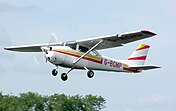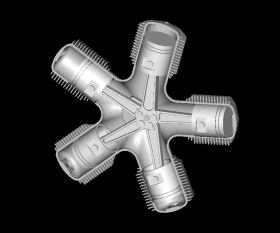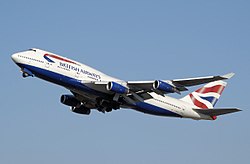Effects of the storage conditions on the stability of natural and synthetic cannabis in biological matrices for forensic toxicology analysis: An update from the literature
| Main page | Categories & Main topics |
|
Tasks and Projects |
The Aviation Portal

Aviation includes the activities surrounding mechanical flight and the aircraft industry. Aircraft includes fixed-wing and rotary-wing types, morphable wings, wing-less lifting bodies, as well as lighter-than-air craft such as hot air balloons and airships.
Aviation began in the 18th century with the development of the hot air balloon, an apparatus capable of atmospheric displacement through buoyancy. Some of the most significant advancements in aviation technology came with the controlled gliding flying of Otto Lilienthal in 1896; then a large step in significance came with the construction of the first powered airplane by the Wright brothers in the early 1900s. Since that time, aviation has been technologically revolutionized by the introduction of the jet which permitted a major form of transport throughout the world. (Full article...)
Selected article

Selected image

Did you know
..that an aircraft's pitot-static system allows a pilot to monitor airspeed, Mach number, altitude, and altitude trend?
- ...that the Bede BD-4 (pictured) was the first homebuilt aircraft to be offered in kit form?
... that the loss of nine military crew members and passengers when Buffalo 461 was shot down over Syria in 1974, remains the largest single-incident loss of life in Canadian peacekeeping history?
General images -
In the news
- May 29: Austrian Airlines cancels Moscow-bound flight after Russia refuses a reroute outside Belarusian airspace
- August 8: Passenger flight crashes upon landing at Calicut airport in India
- June 4: Power firm helicopter strikes cables, crashes near Fairfield, California
- January 29: Former basketball player Kobe Bryant dies in helicopter crash, aged 41
- January 13: Iran admits downing Ukrainian jet, cites 'human error'
- January 10: Fire erupts in parking structure at Sola Airport, Norway
- October 27: US announces restrictions on flying to Cuba
- October 3: World War II era plane crashes in Connecticut, US, killing at least seven
- September 10: Nevada prop plane crash near Las Vegas leaves two dead, three injured
- August 6: French inventor Franky Zapata successfully crosses English Channel on jet-powered hoverboard
Related portals
Associated Wikimedia
The following Wikimedia Foundation sister projects provide more on this subject:
-
 Commons
Commons
Free media repository -
 Wikibooks
Wikibooks
Free textbooks and manuals -
 Wikidata
Wikidata
Free knowledge base -
 Wikinews
Wikinews
Free-content news -
 Wikiquote
Wikiquote
Collection of quotations -
 Wikisource
Wikisource
Free-content library -
 Wikiversity
Wikiversity
Free learning tools -
 Wikivoyage
Wikivoyage
Free travel guide -
 Wiktionary
Wiktionary
Dictionary and thesaurus
Selected biography
Selected Aircraft

The Boeing 747 is a widebody commercial airliner, often referred to by the nickname Jumbo Jet. It is among the world's most recognizable aircraft, and was the first widebody ever produced. Manufactured by Boeing's Commercial Airplane unit in the United States, the original version of the 747 was two and a half times the size of the Boeing 707, one of the common large commercial aircraft of the 1960s. First flown commercially in 1970, the 747 held the passenger capacity record for 37 years.
The four-engine 747 uses a double deck configuration for part of its length. It is available in passenger, freighter and other versions. Boeing designed the 747's hump-like upper deck to serve as a first class lounge or (as is the general rule today) extra seating, and to allow the aircraft to be easily converted to a cargo carrier by removing seats and installing a front cargo door. Boeing did so because the company expected supersonic airliners (whose development was announced in the early 1960s) to render the 747 and other subsonic airliners obsolete; while believing that the demand for subsonic cargo aircraft would be robust into the future. The 747 in particular was expected to become obsolete after 400 were sold but it exceeded its critics' expectations with production passing the 1,000 mark in 1993. As of September 2023, 1,574 aircraft have been built, with the final delivery in January 2023.
The 747-8, the latest version in service, is among the fastest airliners in service with a high-subsonic cruise speed of Mach 0.855 (564 mph or 908 km/h). It has an intercontinental range of 7,730 nautical miles (14,320 km; 8,900 mi). The 747-8I (passenger version) can accommodate 467 passengers in a typical three-class layout. The 747-8 completed production on 6 December 2022 and the final 747 was delivered to Atlas Air on 31 January 2023.
Today in Aviation
- 2012 – A Sudanese Air Force PT-6A crashed at Port Sudan city airport, two crew killed.
- 2011 – On final approach to Petrozavodsk Airport near Petrozavodsk, Russia, after a flight from Moscow's Domodedovo International Airport, RusAir Flight 243, the Tupolev Tu-134A-3 RA-65691, lands short of the runway due to poor visibility and weather, killing 47 passengers and crew members and leaving all five survivors injured. The aircraft is written off.
- 2010 – The 2010 Cameroon Aéro Service CASA C-212 Aviocar crash near Djoum, Cameroon, kills all 11 on board, including the entire board of Sundance Resources, an Australian mining conglomerate.
- 2009 – Deceased: American aviator Kenneth L. Reusser, 89.
- 2004 – Frontier Airlines begins service to Nashville, Tennessee.
- 1996 – Launch: Space Shuttle Columbia STS-78 at 10:49:00.0075 a.m. EDT. Mission highlights: Spacelab mission.
- 1983 – First flight of the Bombardier Dash 8
- 1980 – Test pilot and barnstormer Herman "Fish" Salmon dies in the crash of a Lockheed Constellation he is ferrying to Alaska.
- 1979 – Nikola Kavaja, a Serbian nationalist and anti-communist, hijacks American Airlines Flight 293, a Boeing 727, shortly before it lands in Chicago, Illinois, intending to gain control of an aircraft that he can crash into Yugoslav Communist Party headquarters in Belgrade, Yugoslavia. He allows the passengers and most of the crew to debark, then orders the crew to fly the 727 to LaGuardia Airport in New York City. There he demands and receives a Boeing 707, which he orders to be flown to Shannon, Ireland, where he intends to take control of the 707 for the suicide flight to Belgrade, but the hijacking ends when he surrenders to authorities in Shannon.
- 1973 – Aeroméxico Flight 229, a Douglas DC-9, crashes into the side of Las Minas Mountain while on approach to Lic. Gustavo Díaz Ordaz International Airport; all 27 on board die.
- 1972 – Airline pilots hold a worldwide strike, calling for tighter security
- 1966 – Sheila Scott completes a solo round-the-world flight
- 1964 – Civil Air Transport Flight B-908, a Curtiss C-46, crashes near Shenkang, Taiwan, killing all 57 on board.
- 1958 – First flight of the Westland Wessex
- 1956 – Linea Aeropostal Flight 253, a Lockheed L-749 Constellation, crashes into the Atlantic Ocean off Asbury Park, New Jersey. All 74 passengers and crew on board are killed.
- 1956 – The US Navy commissions its first helicopter carrier, USS Thetis Bay
- 1955 – Exercise Carte Blanche. It was the largest NATO air defence exercise, involving all 12 RCAF Air Division squadrons. Some 300 aircraft took part, nearly 2500 RCAF sorties.
- 1951 – First flight of the Bell X-5, first aircraft with swing wings flies for 30 min at Edwards, California.
- 1951 – The first aircraft completely designed and built in Canada, the first example of the Orenda-powered Avro Canada CF-100 Mk 2 Canuck, flies for the first time at Malton, Ontario.
- 1950 First flight of the Blackburn Beverley
- 1944 – TWA Flight 277, a Douglas C-54 Skymaster, crashes into Fort Mountain, Maine, in severe weather, killing all 7 passengers and crew on board.
- 1944 – On the second and final day of the Battle of the Philippine Sea, 216 Task Force 58 aircraft make the only raid of the battle against the Japanese fleet at extremely long range at sunset, sinking the aircraft carrier Hiyo and damaging the aircraft carriers Zuikaku and Chiyoda, battleship Haruna, and heavy cruiser Maya. In addition to 20 aircraft missing and presumed shot down, Task Force 58 loses 80 planes, which ditch due to fuel exhaustion or crash while attempting night landings on U. S. carriers. During the day, the Japanese lose another 65 carrier aircraft, leaving them with only 35; during the two days of battle, they have lost 476 carrier- and land-based aircraft and battleship- and cruiser-based floatplanes.
- 1944 – Los Negros-based U. S. Army Air Forces B-24 Liberators of the Thirteenth Air Force bomb Woleai.
- 1944 – Allied aircraft begin concentrated attacks on Japanese forces on Noemfoor. By July 1, they will have dropped about 800 tons (725,755 kg) of bombs on the island.
- 1942 – In North Africa, Axis forces begin the final phase of the Battle of Gazala with a massive aerial bombardment of Tobruk by between 296 and 306 aircraft. Tobruk surrenders the next day.
- 1941 – The United States Department of War creates the United States Army Air Forces, with General Henry H. Arnold as its first commander. As part of the reorganization, General Headquarters Air Force is renamed Air Force Combat Command; the new Army Air Forces organization consists of Air Force Combat Command (its combat element) and the United States Army Air Corps (its logistics and training element).
- 1939 – Test flight of first rocket plane using liquid propellants.
- 1935 – Douglas Y1O-35, 32-319, c/n 1119, of the 88th Observation Squadron, suffers loss of power on right engine during takeoff from Griffith Park, Los Angeles, California, for a flight to Rockwell Field, San Diego, California, at ~1000 hrs. Pilot, Cadet Tracy R. Walsh, manages to hop over soldiers breaking camp alongside runway but does not have sufficient flying speed. Airplane crashes through a tent, a fence, and into an automobile, demolishing itself, the vehicle, and killing three civilians in the car. Three crew on plane unhurt. O-35 surveyed and dropped from records at March Field, 15 October 1935.
- 1926 – The United States Coast Guard opens the first permanent Coast Guard Air Stations.
- 1925 – Off New England, a United States Coast Guard Vought UO-1 becomes the first aircraft to pursue a rum-runner.
- 1917 – The British war cabinet decides to increase the size of the Royal Flying Corps from 108 to 200 squadrons, with most of increase coming in bomber squadrons.
- 1914 – While the Austro-Hungarian airship Militärluftschiff III (or M.III) hovers over Fischamend testing new camera equipment, an Austro-Hungarian Army pilot tries to loop M.III in a Farman biplane. The airplane strikes the top of the airship, tearing a hole and igniting the escaping hydrogen gas. Both aircraft are destroyed, and both men in the airplane and all seven men aboard M.III are killed. It is the end of the Austro-Hungarian airship program.
- 1913 – First fatality in U.S. Naval aviation occurs when flight instructor Ens. William Billingsley is thrown from pilot seat of the second Wright CH seaplane, B-2, at height of 1,600 feet in turbulent air over Annapolis, Maryland. The passenger, Lt. John Henry Towers, stays with airplane, sustaining injuries when it hits water. Design was modified conversion of Wright Model B with two pusher propellers driven through chains connected to a 60 hp (45 kW) Wright engine.
- 1897 – Percy Pilcher is towed about 750 feet in the Hawk, the fourth of his hang gliders
- 1540 – João Torto, in Viseu, Portugal, builds two pairs of cloth-covered wings, an upper and lower, which are connected by iron hoops. While preparing to jump from the town’s cathedral to the nearby St. Matthew’s fields, he is killed when the elaborated helmet slips over his eyes and he falls onto a roof.
References
- Shortcuts to this page: Portal:Airplanes • P:AVIA
Purge server cache


























































